
Raphael was an Italian artist who is considered one of the three great masters of High Renaissance along with Michelangelo and Leonardo da Vinci. Raphael’s career is divided by art historians into three periods, the early years in Perugia where he was influenced by his master Pietro Perugino; then a period of 4 years from 1504 to 1508 in Florence where he studied, learned and developed from the works of masters like Leonardo and Michelangelo; and finally his last 12 years in Rome where he worked for two popes and became the leading artist of the city beating his artistic rival Michelangelo. Know more about the life, family, career and the mysterious death of Raffaello Sanzio through these 10 interesting facts.
#1 His father was the court painter to the Duke of Urbino
Born on April 6, 1483, in Urbino, Italy, Raffaello Sanzio da Urbino was the only child of Giovanni Santi and his wife Magia di Battista Ciarla. His father was court painter to Federico da Montefeltro, the Duke of Urbino. He gave his son his first instructions in painting. Raphael’s mother died in 1491 when Raphael was 8 and three years later his father’s death left him an orphan at the age of 11. His father had remarried so he had a stepmother with whom he lived but his formal guardian was his only paternal uncle Bartolomeo, a priest.
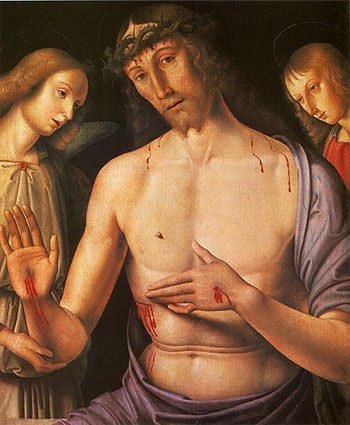
Christ supported by two angels – Painting by Giovanni Santi, Raphael’s father
#2 Raphael’s first documented work is the Baronci Altarpiece
As Federico da Montefeltro encouraged development of fine arts, Urbino had become a center of culture by the time of Raphael’s birth. The cultural vitality of the city was a stimulant for early development of Raphael’s talent and due to his father’s position he came in contact with several important artists of the time. Raphael’s prodigious talent is evident from the fact that in 1500, while still in his teens, he was described as a ‘master’ and commissioned to help paint the Baronci Altarpiece for a church in Castello, a town near Urbino. Completed by September 13, 1502, it is Raphael’s first documented work.
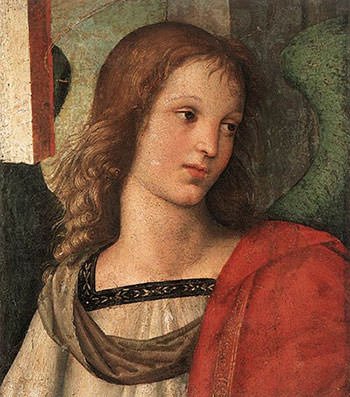
Angel, fragment of the Baronci Altarpiece (1501) – Raphael
#3 His early works were influenced by his master Pietro Perugino
Raphael started working in the city of Perugia around the year 1500. In Perugia, Raphael became a pupil of Pietro Perugino, who was among the leading painters of Italy. From Perugino he acquired extensive professional knowledge. Perugino’s influence is apparent in the early works of Raphael. However these paintings still had several unique characteristics which distinguish them from his master’s works. Raphael’s developing style is apparent in The Marriage of the Virgin, the painting in which he surpasses his master.
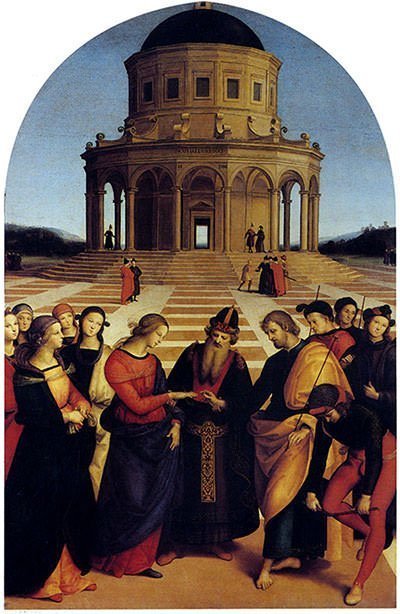
The Marriage of the Virgin (1504)
#4 Leonardo Da Vinci’s art had the greatest influence on his Florentine period works
From around 1504 to 1508, Raphael worked in various centers in Northern Italy, majorly in Florence. Florence opened new artistic horizons for Raphael and he studied the works of masters of the High Renaissance, majorly those of Leonardo, Michelangelo and Fra Bartolommeo. It was Da Vinci’s art that had the greatest influence on Raphael’s works of the Florentine period. Among other things, Raphael used techniques pioneered by Leonardo, like chiaroscuro (strong contrast between light and dark), and sfumato (fine shading to produce soft, imperceptible transitions between colors and tones).
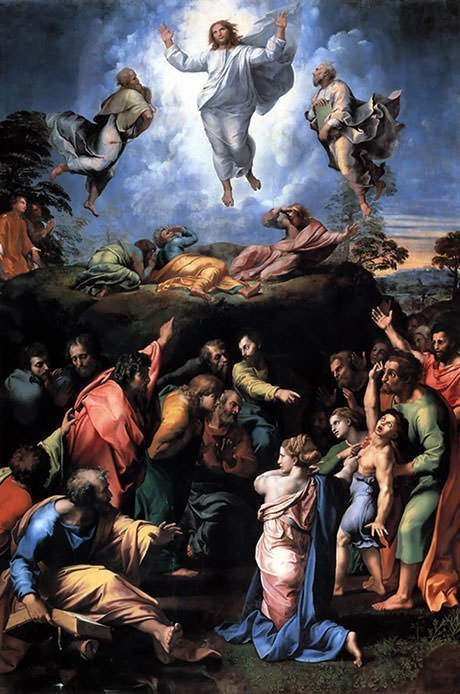
Transfiguration (1520) – One of Raphael’s most celebrated artworks and notable for the strong use of chiaroscuro throughout
#5 Raphael’s greatest work is his fresco sequence in the Raphael Rooms in Papal Palace
Towards the end of 1508, Raphael was called by Pope Julius II to Rome to paint a cycle of frescoes in a suite of rooms in the Vatican papal apartments. The resulting grand fresco sequence is now regarded a quintessential masterpiece of the High Renaissance. The four rooms frescoed by Raphael are famous as “Raphael Rooms” or “Stanze” and the most famous among them is Stanza della Segnatura (“Room of the Signatura”). It contains four grand paintings which epitomize Philosophy, Poetry, Theology and Law. The School of Athens, which represents Philosophy, is considered Raphael’s greatest masterpiece.
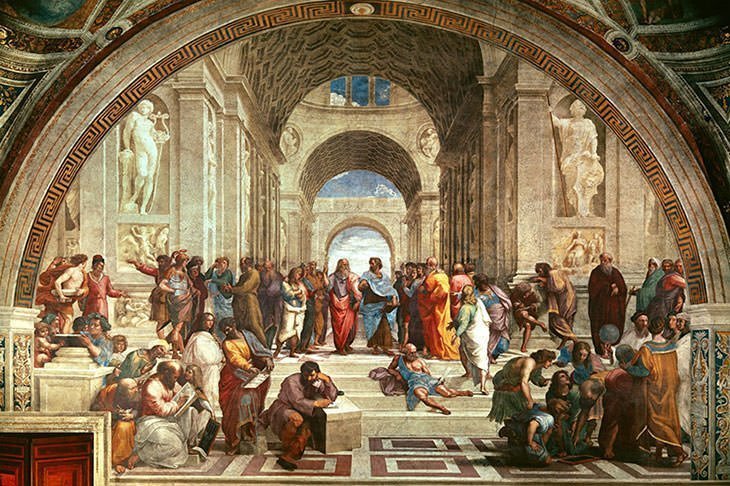
The School of Athens (1509) – Raphael
#6 By 1517 he became the most important artist in Rome
While working on Stanza della Segnatura, Raphael was given the task to design Sant’Eligio degli Orefici, a church in Rome. This was his first architectural project. For a brief period, Raphael became the leading architect in Rome and in 1514, he was asked to design the famous St. Peter’s Basilica in Vatican City. However most of his work on the church was modified or demolished after his death. In 1517, Raphael was appointed commissioner of antiquities of Rome, making him in charge of all of the papacy’s artistic projects in the city, whether involving architecture, painting, decoration or preservation of antiquities.
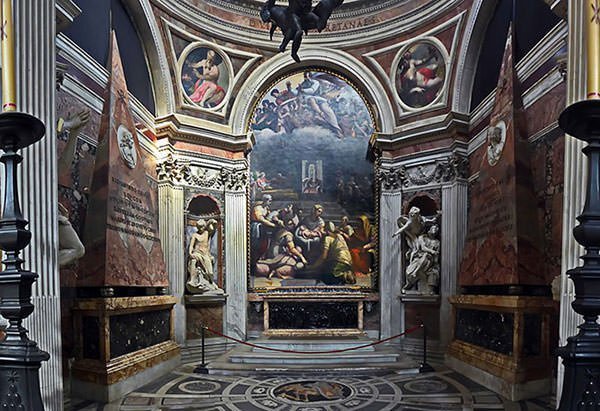
Chigi Chapel in Rome – The only religious building of Raphael preserved in its near original form
#7 Raphael’s most well-known romantic relationship was with Margherita Luti
Raphael’s sweet disposition is well known and throughout his life he mixed effortlessly in the highest of circles. He had a good relationship with Pope Julius II and, after the death of Julius in 1513, an even closer relationship with his successor Pope Leo X. Raphael was affectionate towards the ladies and is said to have had many affairs. His most famous love interest is Margherita Luti, also known as La Fornarina or “the baker’s daughter”. The story of their love has become “the archetypal artist-model relationship of Western tradition”. Two famous Raphael portraits depicting Luti are La Fornarina and La donna velata.
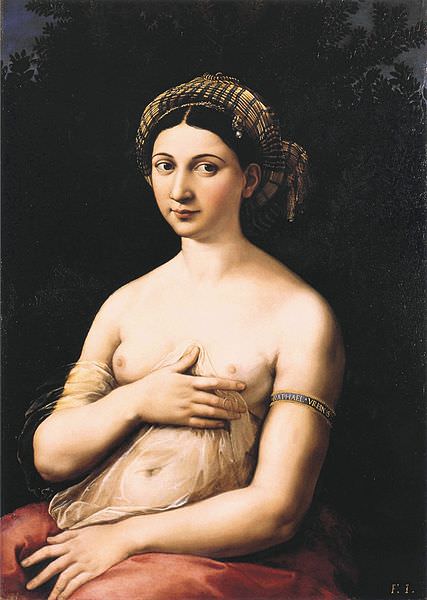
La Fornarina (1519) – Portrait of Margherita Luti by Raphael
#8 It is said that Raphael’s death was caused due to excessive sex
Raphael died on his 37th birthday on Good Friday, April 6, 1520. He never married. He did have an engagement with Maria Bibbiena in 1514 but was not too enthusiastic towards marrying her. The reason for Raphael’s death is not known with certainty. According to art historian Giorgio Vasari, Raphael’s premature death was caused due to a night of excessive sex with Luti after which he fell into a fever. He posits that Raphael didn’t tell the doctors of the cause and was hence given wrong medicine leading to his death. Raphael’s funeral was extremely grand and was attended by a large crowd. His famous painting Transfiguration was placed at the head of the bier, and his body was buried in the Pantheon in Rome.
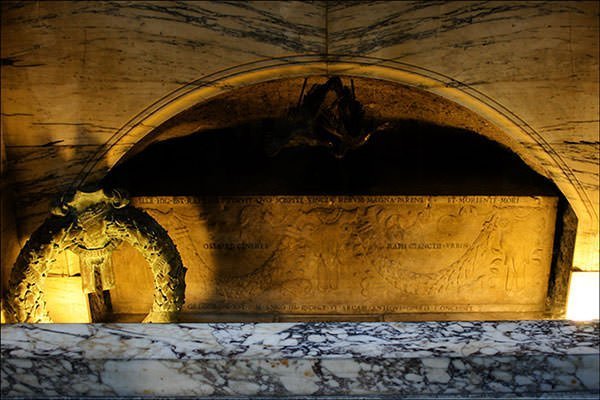
Grave of Raphael in the Pantheon in Rome, Italy
#9 Raphael was involved in a bitter rivalry with Michelangelo
Raphael had a bitter rivalry with Michelangelo. They competed for patrons and their works were compared by their contemporaries as well as the public. Due to his more amiable disposition Raphael was more favored of the two and by 1513 he was scooping up all the best commissions. Raphael became perhaps the most popular painter of the Renaissance and was even called “the prince of painters.” However due to Raphael’s untimely death, Michelangelo’s influence became more widespread. He even declared: “Everything he (Raphael) knew in art he learnt from me.”

Potrait of Michelangelo
#10 In 18th and 19th century, Raphael was considered the greatest Renaissance painter
Raphael’s art is known for sweetness and clarity of form, serenity, harmony, perfection and visual brilliance. Along with Leonardo and Michelangelo, he forms the trinity of great Renaissance masters. Though Raphael was influenced by both, his idealized aesthetically pleasing depictions differed from their dark intensity. For a period between late 17th and late 19th centuries, Raphael’s works were revered more than any other artist and he was regarded as the best model for history painting. Though Michelangelo’s and Leonardo’s fame has surpassed his since then, Raphael is still considered among the greatest artists in history.

Raphael – Self Portrait
Raphael And Madonna & Christ Child
Raphael is among the most revered artists in the genre of history painting but he also excelled in portraiture and was one of the finest draftsmen in the history of western art. Though now his greatest masterpiece is considered the work he did in the Raphael Rooms, his popularity during his time was not due to his major works but due to the numerous small pictures he painted of Madonna and Christ Child. These beautiful works depicting the calm Madonna and the playful Christ remain hugely popular even today.
https://learnodo-newtonic.com/raphael-facts
Комментариев нет:
Отправить комментарий